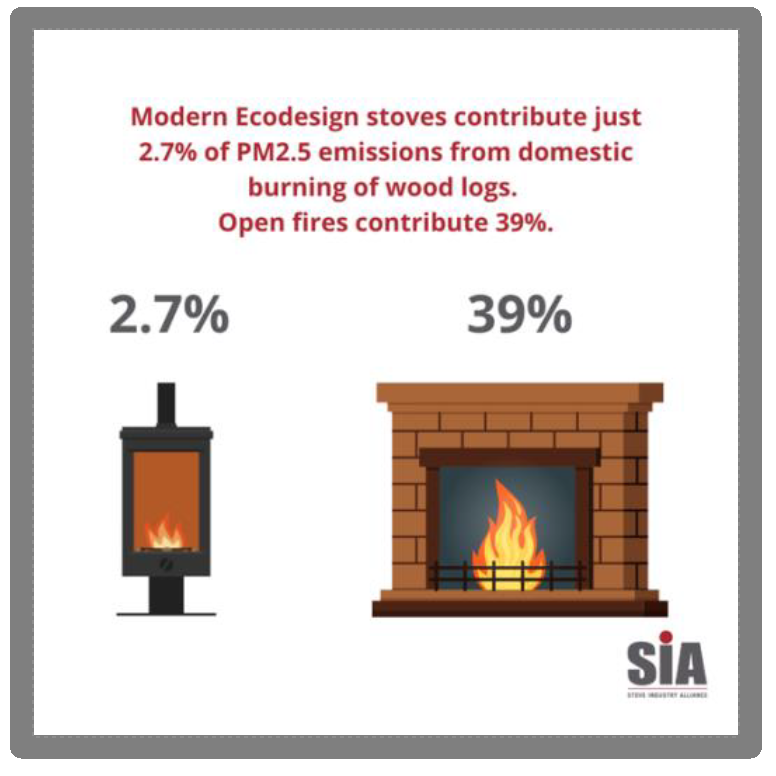Indoor air pollution causes a wide range of issues, which can cause both environmental and physical problems. It’s been reported that wood-burning stoves are the main offenders of indoor pollution. However, according to a literature review by Dr Amanda Lea-Langton, senior lecturer in Bioenergy Engineering at the University of Manchester, which looked at studies into how wood-burning stoves contributed to particular matter (PM) in the developed world, shows no scientific evidence for adverse health effects.

Exposure to high levels of particulate matter (PM) has been linked to a variety of serious health impacts, including lung cancer, Chronic obstructive pulmonary disease (COPD) and other cardiovascular (CV) disease.
There are many sources of PM in the home, such as personal care products, candles, cleaning, cooking and burning wood. The aforementioned literature review shows:
- No scientific evidence was found for adverse health impacts from exposure to the indoor air typically associated with modern, enclosed wood-burning stoves.
- No association was shown between exposure to indoor wood burning and the risk of asthma in
developed countries. - The use of modern wood-burning stoves may help to improve air quality inside the home due to
the natural draught created during wood stove operation that pulls air from the room into the
appliance and from outside. - Other sources of particulate matter in the home, such as cooking, can release much higher
levels of PM compared to modern, enclosed wood-burning stoves, and could therefore have
greater health risk potential. - In one study, oil-based cooking, such as frying food or grilling meat, had a peak value PM
concentrations significantly higher than the WHO recommended average 24hr exposure limit. - In the same study, the Ecodesign wood burning stove indoor air quality averages during
operation were below the WHO recommended limits.
Air quality in our homes has a significant influence on our health. Sadly, misinformation of the past had wrongly suggested that wood-burning stoves are negatively impacting air quality. This simply is not true. The findings of this review indicate there is no association between exposure to wood-burning stoves and the risk of asthma in developed countries. Wood-burning stoves in this study were glass-fronted stoves and not open fires, which would have a very different impact on indoor pollution.
Notes on keeping your room clear when using a stove.
Despite the benefits of a glass-fronted stove, you do need to be mindful when refuelling and opening the door. Never simply swing the door open. This leads to a rapid change in pressure and may cause some small fumes to escape. You should open the door carefully and slightly, remembering to use stove gloves. The air pressure will settle in just a few seconds. It can then be fully opened, and more logs added.

Other useful stove tips:
While stoves may be a clean way to heat a home, you still need to be aware of the things you should avoid doing to make sure the stove is efficient and clean. Here are a few points to consider:
Don’t Burn Wet Wood:
Burning wet wood significantly increases pollution. When you burn wet wood, you’re greatly increasing the amount of tar forming in your flue, which will increase the chances of a chimney fire. Wood is considered “wet” when it has a moisture content of over 20%. When you burn wet wood, the heat output is far from optimal; wet wood also creates excessive smoke too. When you buy wood, look for the Ready to Burn logo, which assures the wood is seasoned correctly and is not considered “wet”.
Don’t Burn Coal:
Coal is a fossil fuel – polluting and non-renewable. When coal is burnt, it produces a lot of pollution, which can aggravate breathing conditions. It’s not ideal to use on a stove and should be discouraged.
Don’t Slumber:
Slumbering is when you set it to burn at a low output. The reduced burn rate can cause congestion to the stove and the flue due to condensation and the release of various chemicals. You should always ensure your stove has a visible flame and remember to use the air vents correctly.
Keep it Clean:
Make sure that your stove is kept clean by not burning wet wood or any material not suitable for a stove. Also, make sure your chimney is swept regularly when in use, remembering to do so at the start and end of the season.